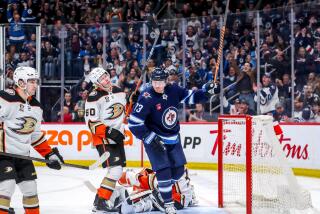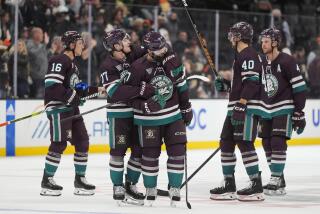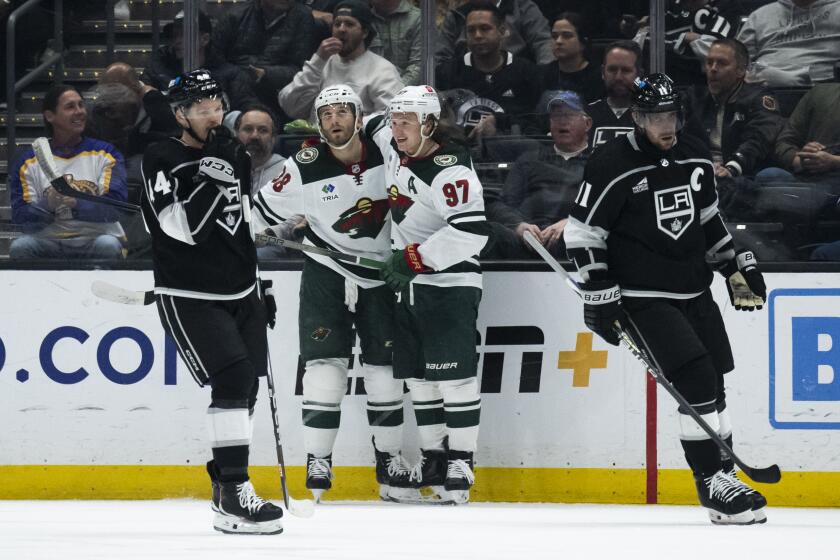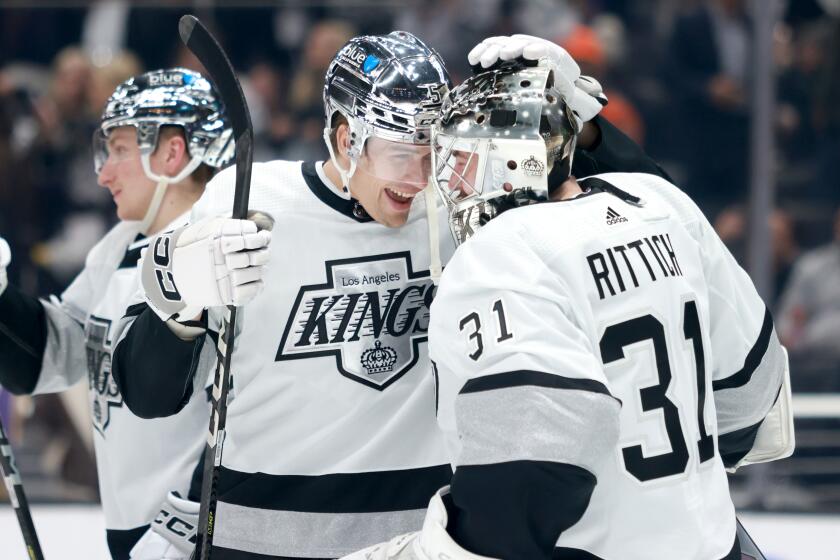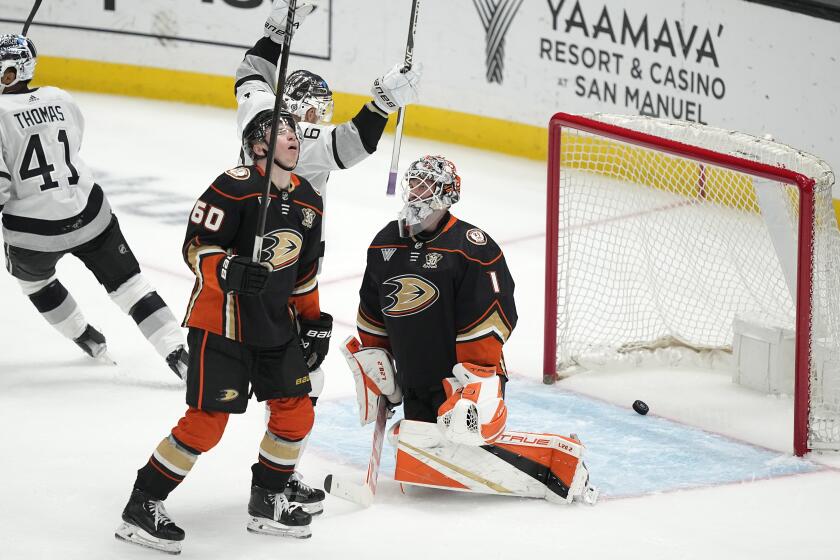Column: Anaheim’s Emerson Etem keeps working on polishing his game for Ducks

Anaheim’s Emerson Etem looks on during a game earlier in the season.
Emerson Etem had been waiting for this moment for a long time, and it unfolded in a flash.
Dashing up the left side with the Ducks down a goal Wednesday in Game 4 of their first-round playoff series against Winnipeg, Etem saw backskating Jets defenseman Jacob Trouba as the only obstacle between him and the net with defenseman Ben Chiarot on the other side of the ice.
“I worked on a lot this summer trying to get to the middle of the ice, and I don’t feel like, at least in the regular season, I’ve been doing a good job if I had that much time and that much space to do something with it,” the Long Beach native said. “So for once, I just wanted to get the D-man kind of confused there. Maybe Trouba thought I was going outside. I made him cross over once, and I went back inside, and I saw the [other] D-man sliding across. I was already on my backhand, and I just chipped it over.”
He eluded Trouba and late-arriving forward Adam Lowry and took a close-in backhander that went over a diving Chiarot and past goaltender Ondrej Pavelec, a shot that was dazzling in its difficulty and impeccable in its timing.
“It was such a huge goal for our team to tie it up, especially late in the first period after they had just scored,” Ducks defenseman Cam Fowler said. “It was one of the goals of the year, in my opinion.”
The Ducks never trailed again, completing their sweep of the Jets with a 5-2 victory that will match them against Calgary. Getting a week off to practice and rest was the biggest reward for their work, but they also got the bonus of seeing what Etem can do at his best, a level the 2011 first-round draft pick hasn’t consistently maintained.
Etem, who split this season between the Ducks and their farm team in Norfolk, Va., has had his moments. Coach Bruce Boudreau said Etem’s slick goal reminded him of the winger’s three-goal, five-point effort in a seven-game loss to the Red Wings in 2013. “Two years ago, when we played Detroit, he might have been our best player in the whole playoffs,” Boudreau said. “It’s good to see.”
The trick for Etem is to continue to find ways to create time and space and finish his chances, even if they’re not as stunning as that goal against Winnipeg. In 45 games with the Ducks this season, he had five goals and 10 points and was minus-six defensively; with Norfolk he had 13 goals and 21 points in 22 games and was minus-one.
“He’s always had that kind of potential. It takes a while for someone to get comfortable in their game, especially come playoff time, and you can see Emerson has developed a lot of confidence now, and he’s been a real steady player for us,” Fowler said Saturday after the Ducks practiced at Anaheim Ice. “He makes it tough on the opposition with his speed, and I think that’s one of the reasons why you saw that goal.
“I can see as a D-man, he’s coming down at you full speed, you think you might want to challenge it wide and you take one step out there, and he’s able to kind of slip it through. That’s what I think made that goal so cool. He has a variety of ways that he can beat you, and that was a great one.”
Etem’s progress hasn’t been linear, but he’s only 22. And though he lives in Anaheim, he still visits Long Beach for weekly home-cooked meals with his father, Richard, and mother, Patricia, a two-time Olympic rower.
“I think it takes a little bit, sometimes, of maturity,” Boudreau said. “It takes a little longer for some players, and when they get it, they’re good to go.”
Etem isn’t leaving that to chance. Long after most players had left the ice Saturday, exhausted by a taxing practice and eager to get a head start on Sunday’s day off, Etem repeatedly took one-timers from the right circle off feeds from Rickard Rakell. He fanned on some and scored on others, but the drill had a purpose.
“Sometimes the ice is bad after practice, and once you get that bad ice, it kind of replicates that late-third or overtime mentality,” he said, referring to the chewed-up state of most rinks late in games. “Hopefully I can do a better job of getting the one-timers off in a game, but that’s why you’re out there practicing.”
That work might pay off soon, just as his work on getting to the middle of the ice paid off in his memorable Game 4 goal.
Twitter: @helenenothelen
More to Read
Go beyond the scoreboard
Get the latest on L.A.'s teams in the daily Sports Report newsletter.
You may occasionally receive promotional content from the Los Angeles Times.

